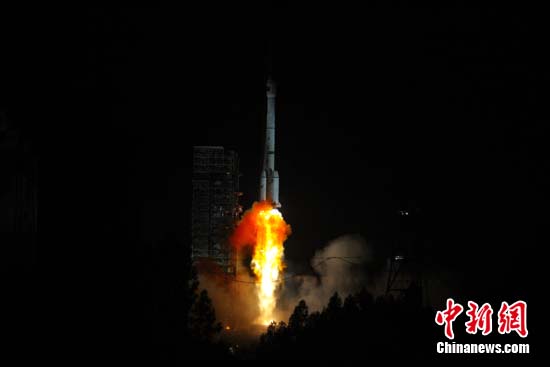Beidou2020
SENIOR MEMBER

- Joined
- Dec 3, 2013
- Messages
- 7,857
- Reaction score
- -48
- Country
- Location

=GT at China Defense Forum
Journey's Start
The Gaofen 4 was launched on December 28, 2015 from Xichang in central China, on a CZ-3B/Long March 3 rocket, to a geosynchronous orbit 22,000 miles above the Earth.
On December 28, 2015, a Long March 3B/G2 rocket launched from Xichang and lofted into space the 4.6 ton Gaofen-4 imaging satellite.

Nasaspaceflight.com
Gaofen 4 Orbit
The GEO orbit of Gaofen 4 means that it can maintain continuous coverage of Chinese territory and surrounding areas. It's also the most powerful GEO satellite, good enough to track aircraft carriers in near real time from space.
Billed as a disaster relief satellite, the Gaofen 4 was placed in Geosynchronous Orbit (GEO). GEO satellites constantly stay above a patch of Earth, thus providing constant 24 hour surveillance of a geographic area. By contrast, low earth orbit (LEO) satellites such as the U.S. KH-11 spy satellites are closer to the Earth, so their speed exceeds that of the Earth's rotation (meaning that they cannot maintain continuous surveillance over specific locations). In the Gaofen 4's case, its range of view is a 7,000km by 7,000km box of 49 million square kilometers of Asian land and water in and around China.

CCTV 13
Gaofen 4
The 4.6 ton Gaofen 4 is the most powerful GEO spy satellite, with a imaging resolution of under 50 meters in color, and 400 meters for thermal imaging.
The Gaofen 4 is the world's most powerful GEO spy satellite. It has a color image resolution of slightly less than 50 meters (which is enough to track aircraft carriers by their wake at sea) and a thermal imaging resolution of 400m (good for spotting forest fires). It may also have a lower resolution video streaming capacity. Because of its round-the-clock coverage of Chinese territory and near aboard, Gaofen 4 can provide instant coverage of earthquake or typhoon hit areas to support humanitarian relief. It will also allow China to monitor strategic foreign sites such as WMD facilities and naval bases inside its observation box.

ChinaSpaceflight.com
The High Ground
As a high orbiting GEO satellite, the Gaofen 4 would be very difficult to attack with anti-satellite weapons.

Jilin Provincial Government
Jilin Constellation
When the Jilin satellite constellation is completed in 2030, it will have 138 small satellites that provide a snapshot of any place on Earth every ten minutes.
The satellite is part of the dual use China High-Resolution Earth Observation System (CHEOS), which already has five other satellites (Gaofen 1, 2, 3, 5 and 8). This fits within a larger program of radar, imaging, hyperspectral and atmosphere monitoring satellites that will support Chinese civilian missions like agriculture, construction, disaster relief and climate change monitoring. Of course, the Chinese Aerospace Force (a new branch of the PLA following its December 2015 reorganization) could easily make use of such satellites during Chinese military operations. Also of interest is the Jilin LEO imaging satellites (sponsored by the Jilin Provincial government); the first four Jilin satellites launched in October 2015 and already have 80cm imaging resolution. By 2030, the Jilin constellation will have 138 imaging, high-resolution small satellites that provide all weather coverage of any point on Earth, at 10 minute intervals.

xyz via China Defense Forum
GEO Spy Satellite
This scientific article by Beijing Institute of Space Mechanics and Electricity's Zhang Yue, Wang Chao, Su Yuan and Jiao Jianchao, describes temperature control on a 20+ meter diameter mirror made of optical membrane foil (a smaller satellite can unfold the optical membrane foil to create a larger lens to enable higher resolution). DARPA is also looking at similar concepts to meet American IMINT needs.
With a lifespan of 8 years, the Gaofen 4 will likely be superseded by future GEO observation satellites with higher resolution imaging capabilities. One intriguing possibility is revealed in a study from a Chinese engineering journal. Enterprising scientists propose that a future GEO spy satellite could deploy a foldable telescope lens of over 20 meters diameter, which could be powerful enough provide sub 1-meter resolution (similar to Ball Aerospace and DARPA's Membrane Optics program). Such a futuristic GEO spy satellite wouldn't just be able to find interesting targets like aircraft carriers and missile launcher trucks, it could beam back real time video streams of enemy forces underway.
http://www.popsci.com/gaofen-4-worl...ontinues-chinas-great-leap-forward-into-space








